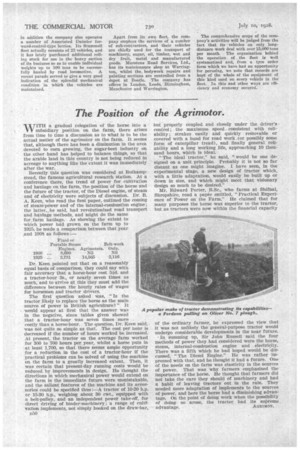The Position of the Agrimotor.
Page 104

If you've noticed an error in this article please click here to report it so we can fix it.
WITH a gradual relegation of the horse into a subsidiary position on the farm, there arises from time to time a discussion as to what is to be the actual metier of the agrimotor on the farm. It seems that, although there has been a diminution in the area devoted to corn growing, the sugar-beet industry on the other hand has helped to balance things, so that the arable land in this country is not being reduced in acreage to anything like the extent it was immediately after the war.
Recently this question was considered at Rotharnpstead, the famous agricultural research station. At a conference there, the trend of power for cultivation and haulage on the farm, the position of the horse and the future of the tractor, of the Diesel engine, of steam and of electricity were subjects of discussion. Dr. B. A. Keen, who read the first paper, outlined the coming of steam-power and of the internal-combustion engine ; the latter,.he said, had revolutionized road transport and haulage methods, and might do the same for farm haulage. As showing the extent to which power hdd grown on the farm up to 1925, he made a comparison between that year and 190S as follows:— Dr. Keen pointed out that on a reasonably equal basis of comparison, they could say with fair accuracy that a horse-hour cost 51d. and a tractor-hour 3s., or nearly seven times as much, and to arrive at this they must add the difference between the hourly rates of wages for horsemen and tractor drivers.
The first question asked was, "Is the tractor likely to replace the horse as the main source of power in British agriculture?" It would appear at first that the answer was in the negative, since tables given showed that a tractor-hour was seven times more costly than a horse-hour. The question, Dr. Keen said, was not quite so simple as that. The cost per hour is decreased if the number of hours worked be increased. At present, the tractor on the average farm worked for 300 to 700 hours per year, whilst a horse puts in at least 1,700, so that there seems ample opportunity for a reduction in the cost of a tractor-hour if the practical problems can be solved of using the machine on the farm to a greatly increased extent. Then, it was certain that present-day running costs would be reduced by improvements in design. He thought the directions in which mechanical power would extend on the farm in the immediate future were unmistakable, and the Salient features of the machine and its accessories could he specified thus :—A tractor of 10-20 h.p. or 15-30 h.p., weighing about 30 cwt., equipped with a belt-pulley, and an independent power take-off, for direct driving of binder-machinery; a range of cultivation implements, not simply hooked on the draw-bar, but properly coupled and closely under the driver's control; the maximum speed. consistent with reliability; strakes easily and quickly removable or covered with a band for road work . (or possibly some form of caterpillar tread), and finally general reliability and a long working life, approaching 10 thousand hours, which is ideal.
"The ideal tractor," he said, "would be one designed on a unit principle. Probably it is not so far distant as one might imagine. I have seen, in the experimental stage, a new design of tractor which, with a little adaptation, would easily be built up or down in size, and which might meet that visionary design so much to be desired."
Mr. Edward Porter, B.Sc., who farms at Shifnal, Shropshire, read a paper entitled, "Practical Experience of Power on the Farm." He claimed that for many purposes the horse was superior to the tractor, but as tractors were now within the financial capacity of the ordinary farmer, he expressed the view that it was not unlikely the general-purpose tractor would undergo considerable developments in the near future.
In summing up, Sir John Russell said the four methods of power they had considered were the horse, steam, internal-combustion engine and electricity. There was a fifth which he had hoped would be 'discussed, "The Diesel Engine." Be was rather impressed with that, and he thought it had a future. One of the needs on the farm was elasticity in the sources of power. That was why farmers emphasized the importance of the horse. He thought that farmers did not take the care they should of machinery and had a habit of leaving tractors out in the rain. They needed more adaptation of implements to the sources of power, and here the horse had a diminishing advantage. On the point of doing work when the possibility of doing so arose, the tractor had its supreme advantage. AGRIMOT.












































































































































































